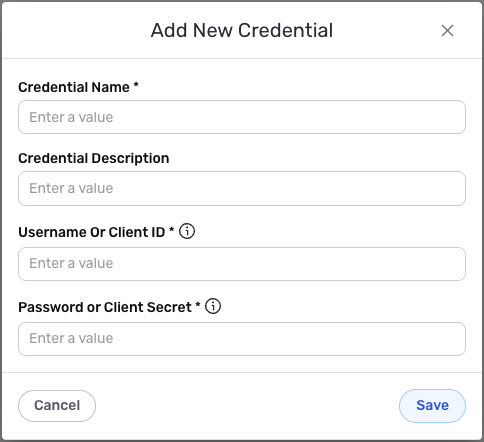Authorization

Hotjar API
Prerequisites
Before creating a Hotjar API credential, you need to obtain a Client ID and Client Secret from your Hotjar account. The Client ID and Client Secret are required for token-based authentication with the Hotjar API.
To obtain your Client ID and Client Secret, you need to have a Hotjar account. Once you have access to your account, you can view and manage your API keys in your Hotjar account settings. The Client ID and Client Secret are used to obtain an access token using the OAuth2 client credentials flow. The access token is then sent in the Authorization header with the Bearer prefix for all API requests to the Hotjar API. For detailed information about API key setup and authentication, refer to the Hotjar API Reference documentation.
Create a Hotjar API Credential
- To create a new Hotjar API credential, after selecting the data source/destination type, click the Add Credential tile to open the Add New Credential overlay.
New Credential Overlay – Hotjar API

Credential Name & Description
-
Enter a name for the credential in the Credential Name field and a short, meaningful description in the Credential Description field.
Resource descriptions are recommended but are not required. They should be used provide information about the resource purpose, data freshness, etc. that can help the owner and other users efficiently understand and utilize the resource.
Token Authentication
Hotjar uses token-based authentication with OAuth2 client credentials flow. The Client ID and Client Secret are used to obtain an access token, which is then used to authenticate API requests.
-
Enter your Hotjar Client ID in the Username Or Client ID field. This is the Client ID you obtained from your Hotjar API key settings. The Client ID must be set to your API key's client ID. The Client ID is used along with the Client Secret to obtain an access token for API authentication.
Your Hotjar Client ID can be found in your Hotjar account settings where you manage API keys. The Client ID must be set to your API key's client ID. The Client ID is used along with the Client Secret to obtain an access token using the OAuth2 client credentials flow. For detailed information about finding your Client ID, see the Hotjar API Reference documentation.
-
Enter your Hotjar Client Secret in the Password or Client Secret field. This is the Client Secret you obtained from your Hotjar API key settings. The Client Secret must be set to your API key's client secret. The Client Secret is used along with the Client ID to obtain an access token for API authentication.
Keep your Client Secret secure and do not share it publicly. The Client Secret provides access to your Hotjar account data and should be treated as sensitive information. Your Hotjar Client Secret can be found in your Hotjar account settings where you manage API keys. The Client Secret must be set to your API key's client secret. The Client Secret is used along with the Client ID to obtain an access token using the OAuth2 client credentials flow. Nexla automatically obtains and refreshes the access token as needed. For detailed information about finding your Client Secret, see the Hotjar API Reference documentation.
Save the Credential
-
Once all of the relevant steps in the above sections have been completed, click the Save button at the bottom of the overlay to save the configured credential.
-
The newly added credential will now appear in a tile on the Authenticate screen during data source/destination creation and can be selected for use with a new data source or destination.